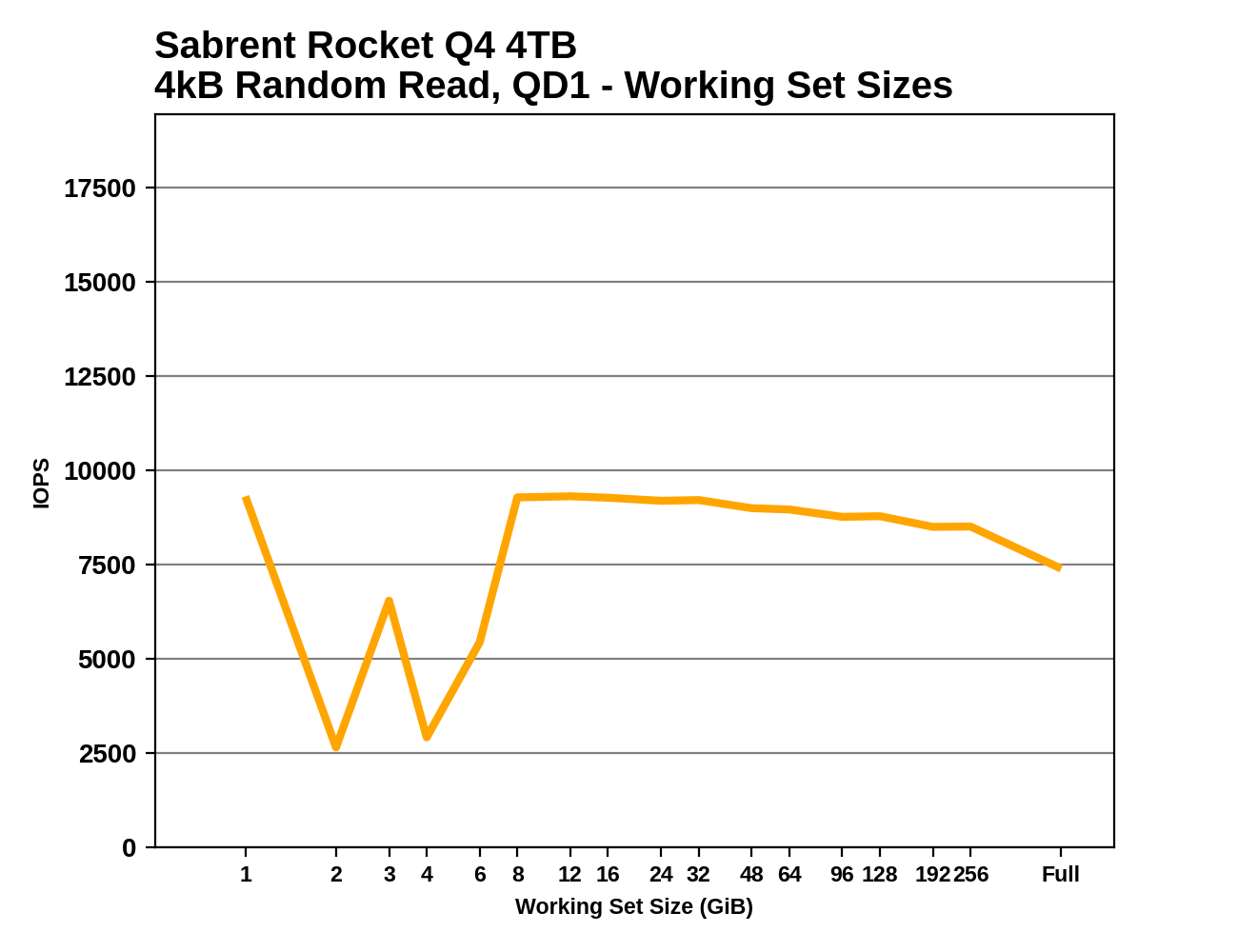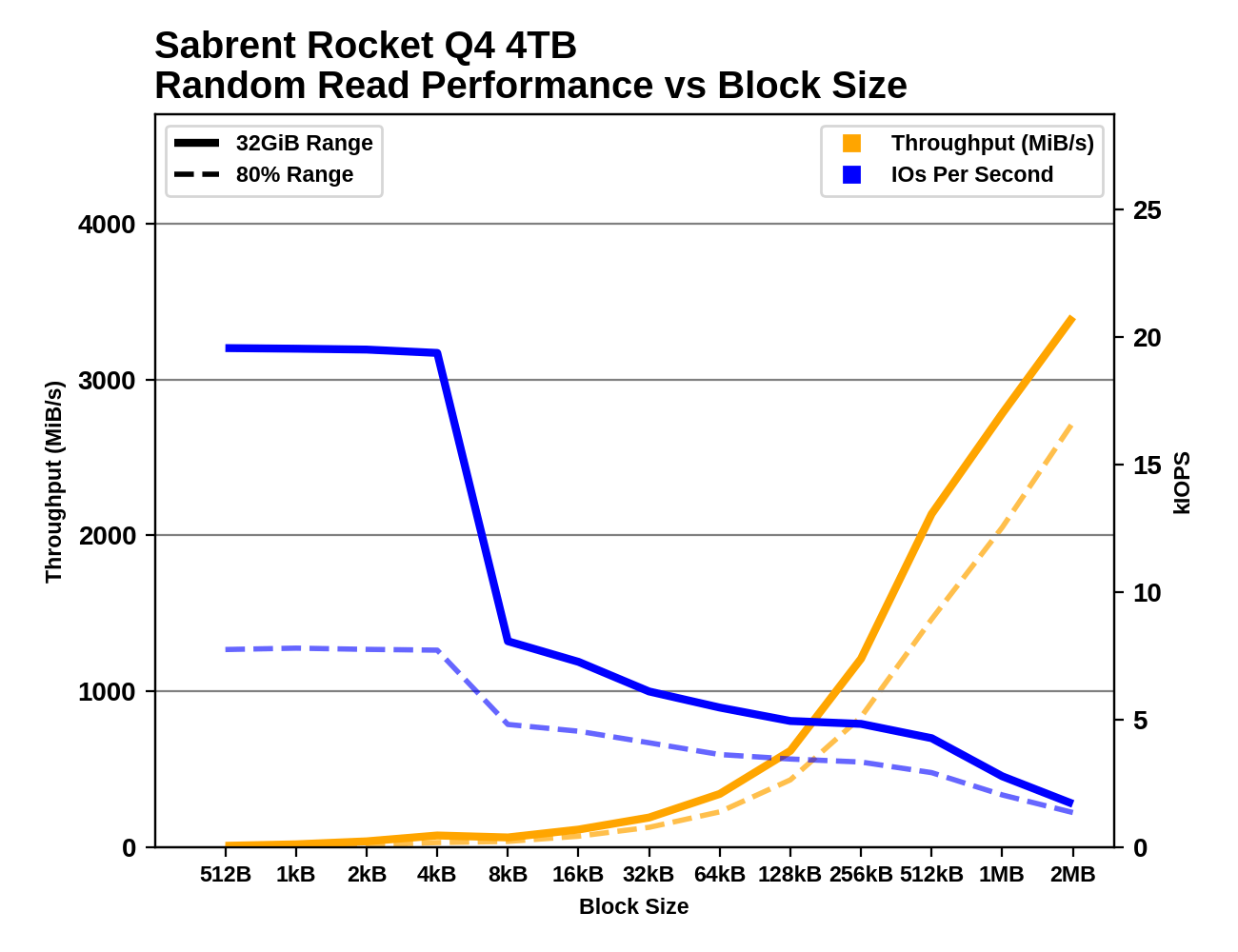Sabrent Rocket Q4 and Corsair MP600 CORE NVMe SSDs Reviewed: PCIe 4.0 with QLC
by Billy Tallis on April 9, 2021 12:45 PM ESTAdvanced Synthetic Tests
Our benchmark suite includes a variety of tests that are less about replicating any real-world IO patterns, and more about exposing the inner workings of a drive with narrowly-focused tests. Many of these tests will show exaggerated differences between drives, and for the most part that should not be taken as a sign that one drive will be drastically faster for real-world usage. These tests are about satisfying curiosity, and are not good measures of overall drive performance. For more details, please see the overview of our 2021 Consumer SSD Benchmark Suite.
Whole-Drive Fill
 |
|||||||||
| Pass 1 | |||||||||
| Pass 2 | |||||||||
As is typical for QLC drives based around Phison controllers, the SLC caches on the Rocket Q4 and MP600 CORE are as large as possible: about 1/4 the usable capacity of the drive. Write speeds to the cache hover around or just above the limit of what a PCIe 3 x4 link could handle, and once the cache is full performance drops down to well below the limit of what a SATA link could handle.
 |
|||||||||
| Average Throughput for last 16 GB | Overall Average Throughput | ||||||||
Both the 2TB MP600 CORE and the 4TB Rocket Q4 have about the same overall write speed, and they're in the middle of the pack of QLC drives: the older 8TB Rocket Q and the more recent Intel 670p both outperform the Phison E16 drives. And all of the TLC drives naturally sustain higher write speeds than any of these QLC drives.
Working Set Size
 |
|||||||||
Both the Rocket Q4 and MP600 CORE have some disappointing performance drops during the working set size test, suggesting there's background work keeping the drives busy despite all the idle time they get before the test and between phases of the test. But aside from that, we see the expected trends: the MP600 CORE has flat overall performance on account of having 2GB of DRAM for its 2TB of NAND, while the Rocket Q4 shows a slight performance decline for large working sets because it's managing 4TB of NAND with the same 2GB of DRAM.
Performance vs Block Size
 |
|||||||||
| Random Read | |||||||||
| Random Write | |||||||||
| Sequential Read | |||||||||
| Sequential Write | |||||||||
The two Phison E16 drives with QLC show similar patterns to the E12 QLC drives, but with substantial performance improvements in several places, most notable for random reads. These drives don't have any issues with block sizes smaller than 4kB, but there are performance drops at larger block sizes where the SLC cache runs out while testing random writes.










60 Comments
View All Comments
phillyry - Friday, April 9, 2021 - link
Thank you for actually posting a table with each of the controllers for the drives instead of assuming we've memorized them all. It's helpful Billy. You guys should explicitly state this in all of your reviews (even if you just say the controller in brackets beside the sdd name).JoeDuarte - Friday, April 9, 2021 - link
Billy, what is this part supposed to say?"competing against drives the cheaper TLC NAND SSD vendors that cut corners."
(On the first page.)
Oxford Guy - Sunday, April 11, 2021 - link
QLC itself is cut corners.You're getting only a 30% density increase for double the voltage states. Diminished returns.
StrangerGuy - Saturday, April 10, 2021 - link
2TB QLC for $300.*yawn*
Oxford Guy - Sunday, April 11, 2021 - link
That kind of pricing should be a scandal.Two years ago Black Friday had NVME PCI-e 3 TLC drives for $200.
Oxford Guy - Sunday, April 11, 2021 - link
'But as more SSD vendors adopt QLC NAND in a wider range of products, some are starting to challenge the assumption that QLC is only for low-quality bargain products.'30% density gain for twice as many voltage states is diminished returns, not an assumption.
QLC working against consumer value by inflating the price of TLC (due to reduction in its economy of scale) is not an assumption either.
GeoffreyA - Sunday, April 11, 2021 - link
I think the folk pushing QLC are trying to sweep its identity under the carpet, in order to sell it at TLC prices. That's their goal. They aren't willing to accept that this is a weaker technology and must be sold at a cheaper price. Sadly, it looks as if TLC will end up being "Pro" and QLC the standard. Their itching, greedy fingers will make sure.It's as if they're trying to sell margarine at the price of butter and working tirelessly to make people forget there even was any difference between the two. "This *is* butter. Go for it. Your heart will thank you."
Katana1074@hotmail.com - Sunday, April 11, 2021 - link
As Usual QLC endurance sucks big time....Oxford Guy - Tuesday, April 13, 2021 - link
'I think the folk pushing QLC are trying to sweep its identity under the carpet'Samsung does that. It labels QLC drives '4-bit MLC' or something. Disgusting.
back2future - Sunday, April 11, 2021 - link
What's the difficulties, if one bit or even one sector is not readable anymore, because of drift inside on cell delivers wrong bit value?What are nowadays updates to data retention?
https://www.anandtech.com/show/9248/the-truth-abou...